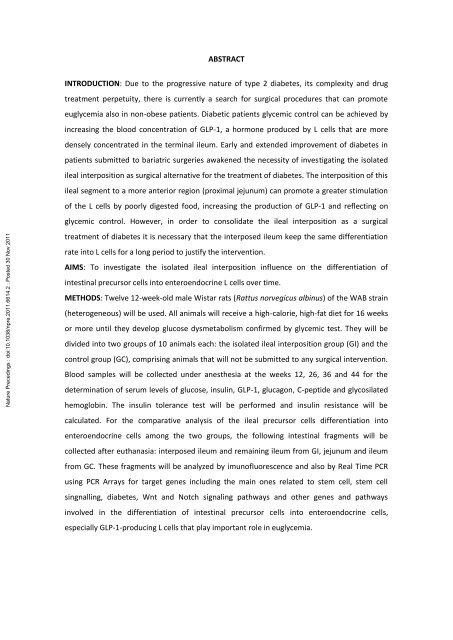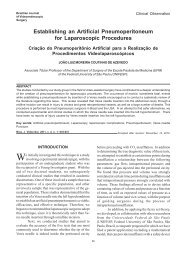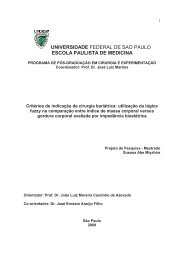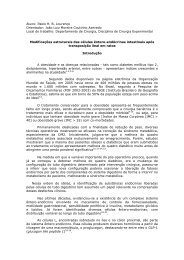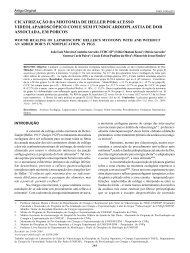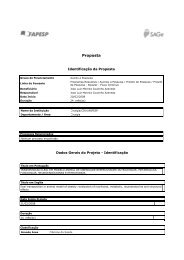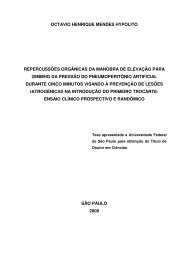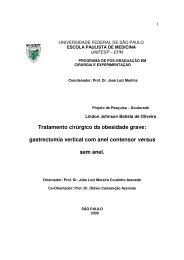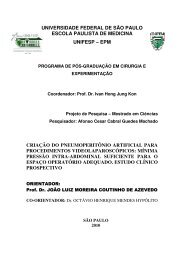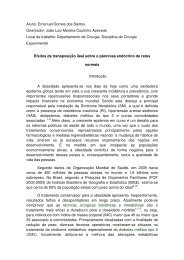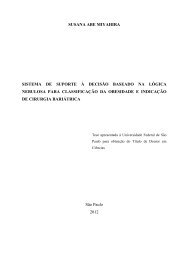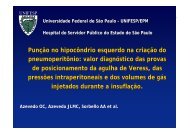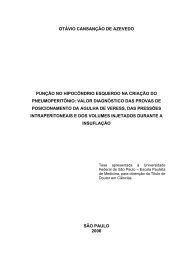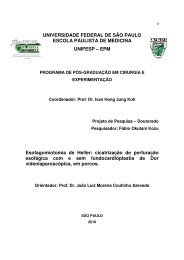Isolated ileal interposition in enteroendocrine L cells differentiation
Isolated ileal interposition in enteroendocrine L cells differentiation
Isolated ileal interposition in enteroendocrine L cells differentiation
You also want an ePaper? Increase the reach of your titles
YUMPU automatically turns print PDFs into web optimized ePapers that Google loves.
ABSTRACT<br />
INTRODUCTION: Due to the progressive nature of type 2 diabetes, its complexity and drug<br />
Nature Preced<strong>in</strong>gs : doi:10.1038/npre.2011.6614.2 : Posted 30 Nov 2011<br />
treatment perpetuity, there is currently a search for surgical procedures that can promote<br />
euglycemia also <strong>in</strong> non-obese patients. Diabetic patients glycemic control can be achieved by<br />
<strong>in</strong>creas<strong>in</strong>g the blood concentration of GLP-1, a hormone produced by L <strong>cells</strong> that are more<br />
densely concentrated <strong>in</strong> the term<strong>in</strong>al ileum. Early and extended improvement of diabetes <strong>in</strong><br />
patients submitted to bariatric surgeries awakened the necessity of <strong>in</strong>vestigat<strong>in</strong>g the isolated<br />
<strong>ileal</strong> <strong><strong>in</strong>terposition</strong> as surgical alternative for the treatment of diabetes. The <strong><strong>in</strong>terposition</strong> of this<br />
<strong>ileal</strong> segment to a more anterior region (proximal jejunum) can promote a greater stimulation<br />
of the L <strong>cells</strong> by poorly digested food, <strong>in</strong>creas<strong>in</strong>g the production of GLP-1 and reflect<strong>in</strong>g on<br />
glycemic control. However, <strong>in</strong> order to consolidate the <strong>ileal</strong> <strong><strong>in</strong>terposition</strong> as a surgical<br />
treatment of diabetes it is necessary that the <strong>in</strong>terposed ileum keep the same <strong>differentiation</strong><br />
rate <strong>in</strong>to L <strong>cells</strong> for a long period to justify the <strong>in</strong>tervention.<br />
AIMS: To <strong>in</strong>vestigate the isolated <strong>ileal</strong> <strong><strong>in</strong>terposition</strong> <strong>in</strong>fluence on the <strong>differentiation</strong> of<br />
<strong>in</strong>test<strong>in</strong>al precursor <strong>cells</strong> <strong>in</strong>to enteroendocr<strong>in</strong>e L <strong>cells</strong> over time.<br />
METHODS: Twelve 12-week-old male Wistar rats (Rattus norvegicus alb<strong>in</strong>us) of the WAB stra<strong>in</strong><br />
(heterogeneous) will be used. All animals will receive a high-calorie, high-fat diet for 16 weeks<br />
or more until they develop glucose dysmetabolism confirmed by glycemic test. They will be<br />
divided <strong>in</strong>to two groups of 10 animals each: the isolated <strong>ileal</strong> <strong><strong>in</strong>terposition</strong> group (GI) and the<br />
control group (GC), compris<strong>in</strong>g animals that will not be submitted to any surgical <strong>in</strong>tervention.<br />
Blood samples will be collected under anesthesia at the weeks 12, 26, 36 and 44 for the<br />
determ<strong>in</strong>ation of serum levels of glucose, <strong>in</strong>sul<strong>in</strong>, GLP-1, glucagon, C-peptide and glycosilated<br />
hemoglob<strong>in</strong>. The <strong>in</strong>sul<strong>in</strong> tolerance test will be performed and <strong>in</strong>sul<strong>in</strong> resistance will be<br />
calculated. For the comparative analysis of the <strong>ileal</strong> precursor <strong>cells</strong> <strong>differentiation</strong> <strong>in</strong>to<br />
enteroendocr<strong>in</strong>e <strong>cells</strong> among the two groups, the follow<strong>in</strong>g <strong>in</strong>test<strong>in</strong>al fragments will be<br />
collected after euthanasia: <strong>in</strong>terposed ileum and rema<strong>in</strong><strong>in</strong>g ileum from GI, jejunum and ileum<br />
from GC. These fragments will be analyzed by imunofluorescence and also by Real Time PCR<br />
us<strong>in</strong>g PCR Arrays for target genes <strong>in</strong>clud<strong>in</strong>g the ma<strong>in</strong> ones related to stem cell, stem cell<br />
s<strong>in</strong>gnall<strong>in</strong>g, diabetes, Wnt and Notch signal<strong>in</strong>g pathways and other genes and pathways<br />
<strong>in</strong>volved <strong>in</strong> the <strong>differentiation</strong> of <strong>in</strong>test<strong>in</strong>al precursor <strong>cells</strong> <strong>in</strong>to enteroendocr<strong>in</strong>e <strong>cells</strong>,<br />
especially GLP-1-produc<strong>in</strong>g L <strong>cells</strong> that play important role <strong>in</strong> euglycemia.


